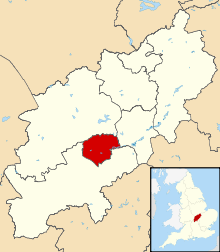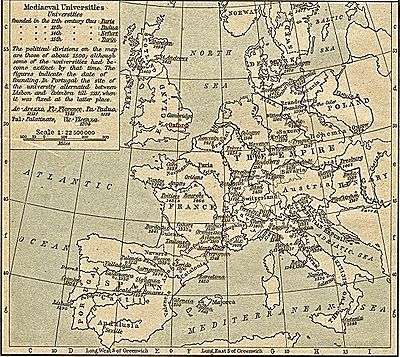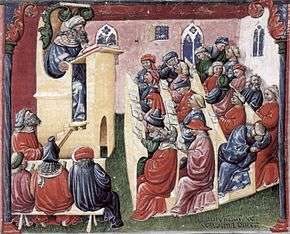University of Northampton (13th century)
The University of Northampton was based in Northampton, England, from 1261 to 1265.
 | |
| Active | 1261–1265 |
|---|---|
| Location | , |

The university was established by royal charter after approval from King Henry III in 1261.[1] It was the third university in England, after Oxford and Cambridge, and the 22nd in Europe. After being advised by bishops and magnates that Northampton was a threat to Oxford, Henry III dissolved the university in 1265, and signed a Royal Decree that banned the establishment of a university in Northampton.
In 2005 the decree was repealed by the Privy Council, allowing the then University College Northampton (founded in 1924) to gain university status and become the University of Northampton.
History
Founding
Northampton was, in the 13th century, a far more important town than is evident today, so it is not particularly surprising that a university was established there. The town was also, briefly, the King's seat.[2]
The University of Northampton was founded in the reign of King Richard I (the ‘Lion-heart’) as a school. Richard patronised the institution and, according to at least one historian, between 1176 and 1193 the school at Northampton ‘rivalled or even eclipsed the Oxford schools’[3] The school lost a powerful supporter with the death of King Richard. However, it still enjoyed the patronage of Simon de Montfort[4] through the reign of King John and his son Henry III.
There were violent 'town and gown' confrontations in Cambridge in 1249, and again in 1260, when there was major rioting resulting in the execution of 16 townsmen and the severe punishment of many more. Following this, several scholars fled seeking sanctuary in Northampton. In 1261 Henry III was requested to give, and granted, permission for the settlement of a university in the town.
Abolition
The existence of the University was brief. Four years after it was established, during the siege of Northampton, the scholars resisted the entry of the King’s forces, which resulted in Henry III revoking the town’s licence to have a University.[5]
Some sources suggest an alternative motive for the closure of the University. As one writer put it[6]"... an interesting proclamation from Henry III suggests a more parochial and self-interested reason for the folding of the town’s 13th century university. On 1 February 1265, Henry wrote to the mayors and burgesses of Northampton:
- "We acceded to their request [to establish a university in 1261] because we believed then that this would benefit your town and that advantage would accrue to us; but now we have learned on the testimony of men worthy of belief that, if the university remains at Northampton, no small damage would be incurred by our borough of Oxford, which is of ancient creation, has been confirmed by our ancestors, and is generally approved as a convenience to students. We should on no grounds be willing that this should happen, especially as all the bishops agree that for the honour of God, the advantage of the church of England and the well being of the students, the university should be removed from Northampton".[7]

This suggests that academic rivalry played a part in the King's decision as evidenced by the advice he received from professors at Oxford on the matter.
The modern University of Northampton
The university's name was revived in 2005 when the then University College Northampton, itself an amalgam of earlier institutions, was upgraded to full university status and renamed the University of Northampton. Other than the name and the location in the town, there is no link between the medieval university and the modern university.
References
- "Reading, a city dreaming of spires". Times Higher Education. 3 May 1996. Retrieved 4 January 2011.
- Andrew, Martin: Northampton (The Francis Frith Collection), 2002.
- Cobban, Alan B., The Medieval Universities: Their Development and Organization (Methuen, 1975)
- J. R. Maddicott, Simon de Montfort (Cambridge University Press, 1996)
- Alan B. Cobban, The Medieval English Universities: Oxford and Cambridge to c. 1500 (Scolar Press, 1988)
- It should have been Northampton.
- F. M. Powicke, Ways of Medieval Life and Thought: essays and addresses. (New York: Biblo and Tannen, 1964).
External links
- https://web.archive.org/web/20111028042113/http://www.northampton.ac.uk/info/20001/about-us/423/history-of-the-university-of-northampton University of Northampton history and dates